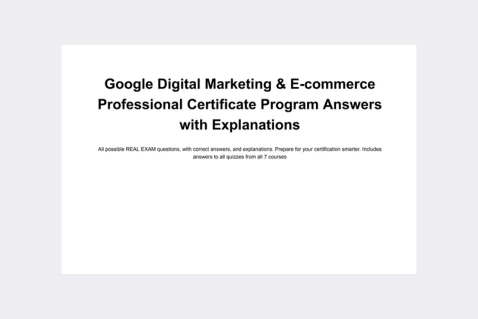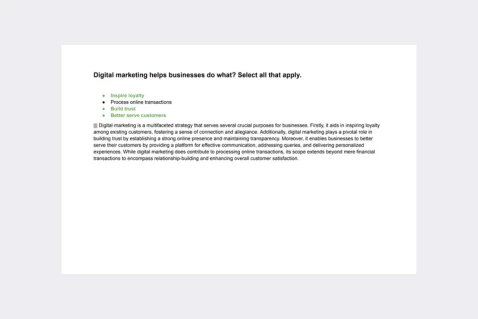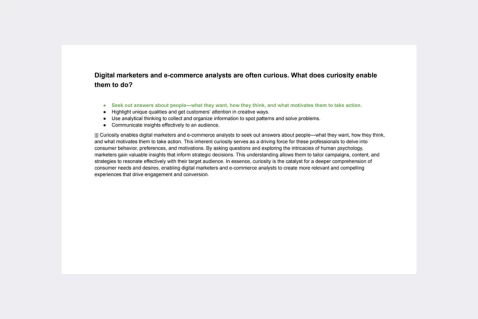As a digital marketer setting up an SEM ad, you include information about the business such as additional website links, a phone number, and an address. What is the term for this additional information?
Ad feature
Ad extension
Information extension
Information feature
Certification program: 👉 Google Digital Marketing & E-commerce Professional Certificate (Coursera)
Explanation: The term for the additional information about the business, including extra website links, a phone number, and an address, is an ad extension. Ad extensions are supplementary details that advertisers can include in their search engine marketing (SEM) ads to provide more comprehensive information to users. In this context, the ad extension enriches the ad with valuable details such as alternative links for users to explore, a contact number for immediate communication, and a physical address for those seeking in-person interaction. These extensions not only enhance the visibility and relevance of the ad but also offer users multiple avenues to engage with the business, aligning with best practices in SEM to create more informative and effective advertisements.
Passing exams is not a workout. Multiple attempts won’t make you stronger.



- All possible certificate program questions
- Real certification exam questions
- Detailed answer explanations.
- Over 1700 questions, 7 courses, 30 quizzes
- Free lifetime updates.
Enhancing Your SEM Ads with Sitelinks and Location Extensions
In the ever-evolving landscape of digital marketing, staying ahead of the competition requires not only creativity but also strategic implementation of available tools and features. When it comes to search engine marketing (SEM), one such feature that can significantly enhance the effectiveness of your ads is the inclusion of additional business information through sitelinks and location extensions.
Understanding Sitelinks and Location Extensions
Sitelinks and location extensions are powerful components that allow digital marketers to provide users with more relevant and actionable information directly within their search engine ads.
Sitelinks: Directing Users to Relevant Pages
Sitelinks are additional links that appear below the main ad copy in search engine results. These links direct users to specific pages on your website, such as product pages, service offerings, or contact forms. By including sitelinks in your ads, you not only provide users with more options to explore but also increase the likelihood of them finding relevant information quickly and taking the desired action.
Location Extensions: Adding Local Context
Location extensions, on the other hand, enable marketers to display essential business information such as phone numbers, addresses, and maps directly within their ads. This feature is particularly valuable for businesses with physical locations, as it allows them to connect with local customers and drive foot traffic to their stores. By including location extensions, you make it easier for users to find and engage with your business, whether online or offline.
Practical Insights for Utilizing Sitelinks and Location Extensions
To leverage sitelinks and location extensions effectively in your SEM campaigns, consider the following practical insights:
-
Relevance is Key: Ensure that the sitelinks and location information you include in your ads are directly relevant to users’ search queries and align with their intent. This increases the likelihood of engagement and conversion.
-
Highlight Key Offerings: Use sitelinks to showcase your most popular products, services, or features. This allows users to navigate to the information they’re interested in quickly, improving their overall experience and driving higher click-through rates.
-
Optimize for Mobile: With an increasing number of users accessing search engines on mobile devices, it’s essential to ensure that your sitelinks and location extensions are optimized for mobile visibility and functionality. Make sure they display correctly and provide a seamless experience across all devices.
-
Test and Iterate: Don’t be afraid to experiment with different sitelinks and location information to see what resonates most with your audience. A/B testing can help you identify which elements drive the best results and refine your strategy accordingly.
-
Monitor Performance Metrics: Track key performance metrics such as click-through rate, conversion rate, and store visits (for location extensions) to gauge the effectiveness of your sitelinks and location extensions. Use this data to optimize your campaigns and maximize ROI.
By incorporating sitelinks and location extensions into your SEM ads, you can provide users with more relevant and actionable information, enhance the visibility of your business, and drive better results for your campaigns. Whether you’re directing users to specific pages on your website or providing essential location information, these extensions offer a powerful way to connect with your target audience and achieve your marketing objectives.
Remember, in the world of SEM, every detail counts. So, make sure to leverage sitelinks and location extensions to their fullest potential and stand out in the crowded digital landscape.
Discover our best-value guides
- Special Bundle Offer Google_Ads_Roll
- Special Bundle Offer HubSpot_Exams_Roll
- Special Offer Unchained_Guru_Roll
- Special Bundle Offer Amazon_Roll
- Special Bundle Offer Google_Analytics_Roll
- Special Bundle Offer Google_SkillShop_Roll
- Special Bundle Offer Marketing_Platforms_Roll
- Special Bundle Offer Microsoft_Advertising_Roll
- Special Bundle Offer YouTube_Roll
- Special Bundle Offer Google_Android_Roll
- Ultimate PMP certification preperation guide
- Google Cloud Professional Architect Certification Exam Answers - Ultimate Guide
- Special Bundle Offer SEMrush_Roll